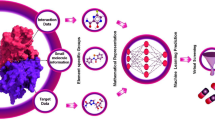Abstract
Topoisomerase-I (TOP-I) has emerged as a potential target for the design and development of anticancer compounds. TOP-I inhibitors have shown promise in the treatment of various cancers including renal cell cancer, whose exact cause is yet to be known. Recent studies indicate that indenoisoquinolines can provide greater stability to drug-topoisomerase-DNA cleavage complexes, which makes them a more appropriate anticancer class of compounds compared to camptothecin. In view of such significance, a three-dimensional pharmacophore model has been developed using a training set of 36 indenoisoquinoline-based topoisomerase inhibitors. The validated best model consists of three chemical features: one hydrophobic, one positive ionizable, and one ring aromatic with good correlation values of r 2(training) = 0.827 and r 2(test) = 0.702. Furthermore, 98 % validation by CatScramble method and a good r 2 of 0.703 from 22 external test set compounds have testified the universal applicability of the generated model. Validated three feature pharmacophore model has been used to screen the chemical database from the National Cancer Institute (NCI) leading to the identification of 17 druggable TOP-I inhibitors which can be raised into drug candidates after further evaluation.






Similar content being viewed by others
References
Cañamares I, Agustin MJ, Santander C, Gomez-Tijero N, de la LLama N, Abad-Sazatornil MR (2012) Safety of sunitinib in renal cell carcinoma. Eur J Hosp Pharm 19:166. doi:10.1136/ejhpharm-2012-000074.215
Champoux JJ (2001) DNA topisomerases: structure, function, and mechanism. Annu Rev Biochem 70:369–413
Cushman M, Jayaraman M, Vroman JA, Fukunaga AK, Fox BM, Kohlhagen G (2000) Synthesis of new indeno[1,2-c]isoquinolines: cytotoxic non-camptothecin topoisomerase I inhibitors. J Med Chem 43:3688–3698
Fortune JM, Osheroff N (2000) Topoisomerase II as a target for anticancer drugs: when enzymes stop being nice. Prog Nucleic Acid Res Mol Biol 64:221–253
Frimayanti N, Yam ML, Lee HB, Othman R, Zain SM, Rahman NA (2011) Validation of quantitative structure activity relationship (QSAR) model for photosensitizer activity prediction. Int J Mol Sci 12:8626–8644
Jaxel C, Kohn KW, Wani MC, Wall ME, Pommier Y (1989) Structure-activity study of the actions of camptothecin derivatives on mammalian topoisomerase I: evidence for a specific receptor site and a relation to antitumor activity. Cancer Res 49:1465–1469
Kohlhagen G, Paull KD, Cushman M, Nagafuji P, Pommier Y (1998) Protein-linked DNA strand breaks induced by NSC 314622, a novel noncamptothecin topoisomerase I poison. Mol Pharmacol 54:50–58
Kurogi Y, Guner OF (2001) Pharmacophore modeling and three dimensional database searching for drug design using catalyst. Curr Med Chem 8:1035–1055
Lindblad P (2004) Epidemiology of renal cell carcinoma. Scand J Surg 93:88–96
Lipinski CA, Lombardo F, Dominy BW, Feeney PJ (1997) Experimental and computational approaches to estimate solubility and permeability in drug discovery and development setting. Adv Drug Deliv Rev 23:3–25
Lu A, Zhang J, Yin X, Luo X, Jiang H (2007) Farnesyltransferase pharmacophore model derived from diverse classes of inhibitors. Bioorg Med Chem Lett 17:243–249
Morrell A, Placzek M, Parmley S, Antony S, Dexheimer TS, Pommier Y et al (2007a) Nitrated indenoisoquinolines as topoisomerase I inhibitors: a systematic study and optimization. J Med Chem 50:4419–4430
Morrell A, Placzek M, Parmley S, Grella B, Antony S, Pommier Y et al (2007b) Optimization of the indenone ring of indenoisoquinoline topoisomerase I inhibitors. J Med Chem 50:4388–4404
Nagarajan M, Morrell A, Fort BC, Meckley MR, Antony S, Kohlhagen G et al (2004) Synthesis and anticancer activity of simplified indenoisoquinoline topoisomerase I inhibitors lacking substituents on the aromatic rings. J Med Chem 47:5651–5661
Nagarajan M, Morrell A, Antony S, Kohlhagen G, Agama K, Pommier Y et al (2006) Synthesis and biological evaluation of bisindenoisoquinolines as topoisomerase I inhibitors. J Med Chem 49:5129–5140
Oloff S, Mailman RB, Tropsha A (2005) Application of validated QSAR models of D1 dopaminergic antagonists for database mining. J Med Chem 48:7322–7332
Rekha PR, Rajendiran S, Rao S, Shroff S, Joseph LD, Prathiba D (2008) Histological reclassification, histochemical characterization and c-kit immunoexpression in renal cell carcinoma. Indian J Urol 24:343–347
Scherr AJ, Lima JP, Sasse EC, Lima CS, Sasse AD (2011) Adjuvant therapy for locally advanced renal cell cancer: a systematic review with meta-analysis. BMC Cancer 11:115–122
Thakur A, Jain SK (2011) Kidney cancer: current progress in treatment. World J Oncol 2:158–165
Wang JC (1996) DNA topoisomerases. Annu Rev Biochem 65:635–692
Wang JC (2002) Cellular roles of DNA topoisomerases: a molecular perspective. Nat Rev Mol Cell Biol 3:430–440
Watts KS, Dalal P, Murphy RB, Sherman W, Friesner RA, Shelly JC (2010) ConfGen: a conformational search method for efficient generation of bioactive conformers. J Chem Inf Model 50:534–546
Wilstermann AM, Osheroff N (2003) Stabilization of eukaryotic topoisomerase II-DNA cleavage complexes. Curr Top Med Chem 3:1349–1364
Yoshinari T, Ohkubo M, Fukasawa K, Egashira S, Hara Y, Matsumoto M et al (1999) Mode of action of a new indolocarbazole anticancer agent, J-107088, targeting topoisomerase I. Cancer Res 59:4271–4275
Acknowledgments
The authors thank the Department of Science and Technology, New Delhi and the Vice Chancellor, Banasthali University, for extending all the necessary facilities. The authors also thank Dr. Monali Bhattacharya, Department of English, Banasthali University, for her support.
Author information
Authors and Affiliations
Corresponding author
Rights and permissions
About this article
Cite this article
Singh, S., Das, S., Pandey, A. et al. Pharmacophore-based in silico high-throughput screening to identify novel topoisomerase-I inhibitors. Med Chem Res 22, 5356–5380 (2013). https://doi.org/10.1007/s00044-013-0526-3
Received:
Accepted:
Published:
Issue Date:
DOI: https://doi.org/10.1007/s00044-013-0526-3




